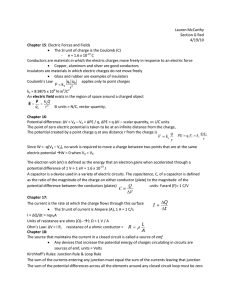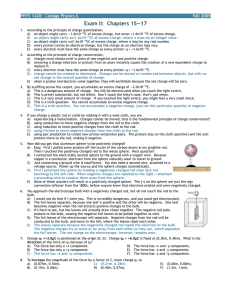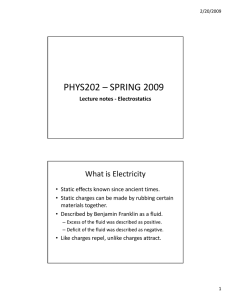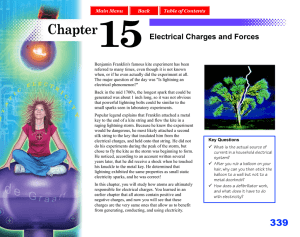Unit 8 - Electrostatics and DC Circuits
advertisement
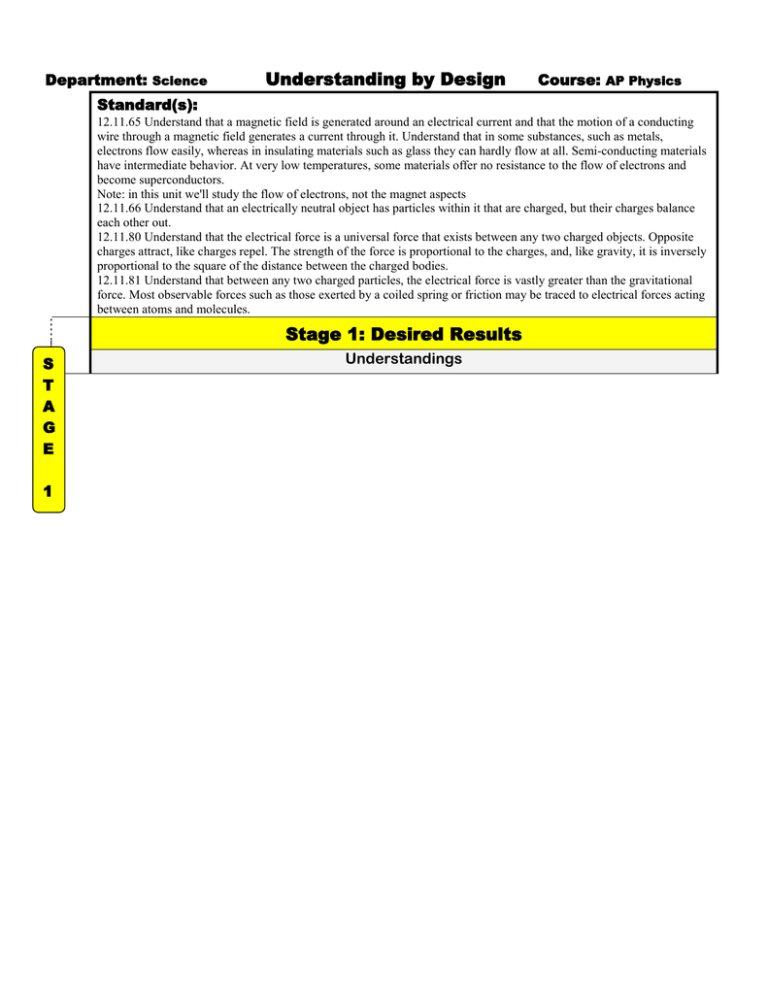
Department: Science Understanding by Design Course: AP Physics Standard(s): 12.11.65 Understand that a magnetic field is generated around an electrical current and that the motion of a conducting wire through a magnetic field generates a current through it. Understand that in some substances, such as metals, electrons flow easily, whereas in insulating materials such as glass they can hardly flow at all. Semi-conducting materials have intermediate behavior. At very low temperatures, some materials offer no resistance to the flow of electrons and become superconductors. Note: in this unit we'll study the flow of electrons, not the magnet aspects 12.11.66 Understand that an electrically neutral object has particles within it that are charged, but their charges balance each other out. 12.11.80 Understand that the electrical force is a universal force that exists between any two charged objects. Opposite charges attract, like charges repel. The strength of the force is proportional to the charges, and, like gravity, it is inversely proportional to the square of the distance between the charged bodies. 12.11.81 Understand that between any two charged particles, the electrical force is vastly greater than the gravitational force. Most observable forces such as those exerted by a coiled spring or friction may be traced to electrical forces acting between atoms and molecules. Stage 1: Desired Results S T A G E 1 Understandings Students will understand the origins of electrical charge, and know that electrons have negative charge and protons have positive charge. Students will know the unit of charge is the coulomb, and that charge is quantized, it only comes in discrete amounts. Students know that in an interaction charge is conserved Students know that like charges repel and opposite charges attract. Students know the difference between conductors, insulators, and semi-conductors. Students know how to charge objects by conduction, friction, or induction, and know what ground or grounding is Students understand Coulomb’s law, and see the relationship or similarities between Coulomb’s law and NULG. Students understand the idea of fields, and specifically the electric field, and see the relationship between electric force and electric field. Students can find and calculate the electric field due to a collection of point charges. Students know what electric field lines are and can draw them in simple cases, and understand the relationship between conductors and electric fields. Students can use Gauss Law in simple cases Students understand how work and electric potential energy are related. Students know it takes work to move charged objects relative to each other, and understand the relationship between electric potential energy and electric potential Students also know what electric potential difference is. Students know an alternative energy unit, the electron volt (eV) Students can find the electric potential due to a collection of point charges, and see the relationship between electric field and equipotential surfaces Students know what a capacitor is, understand what a dielectric material is, can calculate the capacitance of a parallel plate capacitor, and can calculate the energy stored in a capacitor Students understand what is meant by electromotive force, and know it is not a force, but a voltage. Students know how Emf and conductors can make currents and circuits. Students know the difference between DC and AC Students know and can use Ohm’s Law, know how to calculate resistance given resistivity, and know what is meant by Ohmic materials Students know how to calculate electric power, and can relate power, to voltage, current, and resistance Students know about series wiring, and how to calculate equivalent resistance for series Students know about parallel wiring, and how to calculate equivalent resistance for parallel Students can solve simple and complex circuits using Kirchhoff’s Rules. Students know how to calculate equivalent capacitance for series and parallel Students understand the basics of RC circuits, can find the time constant, and understand graphically how capacitors charge and discharge and how current vaires Essential Questions What is charge? How does charge interact with other charge? Can charge store energy? How can I make charge do work for me? Knowledge & Skill Refer to Knowledge and Skills sheet Stage 2: Assessment Evidence S T A G E 2 Chapter test Quizzes Labs Homework Worksheets Performance Task Summary Rubric Titles Laboratory Performance Class Discussions Class and Home Practice Problem Solving Self-Assessments Laboratory Performance Class Discussions Class and Home Practice Problem Solvings Other Evidence, Summarized Other assessment information will be obtained through observations, classroom participation, class discussion and interactions. Stage 3: Learning Activities S T A G E 3 Pertinent Chapters: In Cutnell and Johnson, Chapters 18,19, and 20 Estimated pacing 15 days


